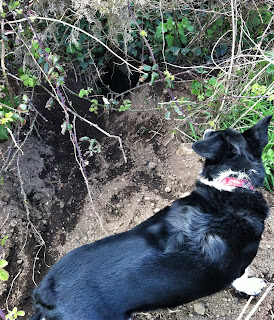Because the plot is south-west facing on the top of a hill, with views for miles around, it also is very exposed and gets hit hard by the wind. Hopefully all plants grown from seed on the site will grow up used to the constant blowing, but the plants we have put in are not coping well with the cold wind. Researching the problem on-line, Joy Larkcom, who has a very windy garden in Ireland suggests tyres around delicate plants. We sourced some old tyres from a local garage, and put them over some of the plants just in time for a night of gales. Wind speeds were 38mph, gusting at 59mph and even according to the paper, reaching 69mph during the worst of the storm. They are not attractive but they do the job. We only had enough tyres for two of the four globe artichokes and they are looking a lot healthier than the unprotected two. The delicate yakon were also protected by tyres.
Globe artichoke inside a tyre
The Yakon protected from most of the wind.
The tyres are not attractive, but they do the job, and most garages are happy to give them away. We will be going back for some more, and are planning to experiment by growing potatoes in a stack of tyres next spring. You put your seed potato in a tyre and cover with earth, when it pokes through you add another tyre and fill with earth, when it pokes through, another tyre and earth, until you have a stack 4 tyres high. As our soil is not that deep, it should provide us with a good crop of potatoes and not take up much room.




























.JPG)